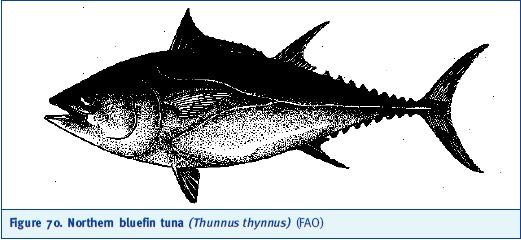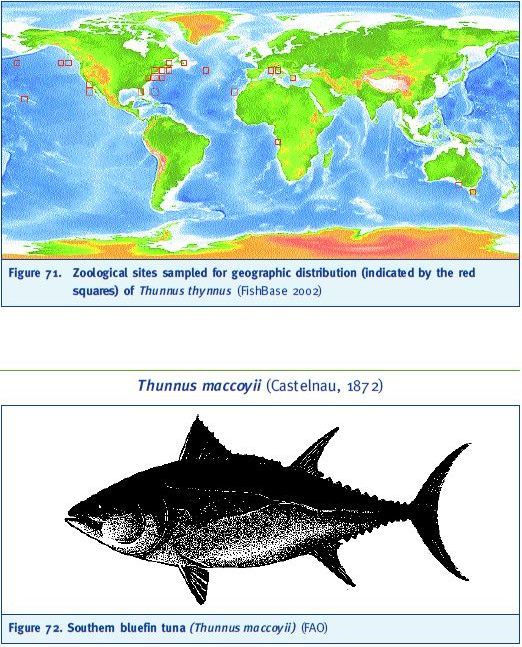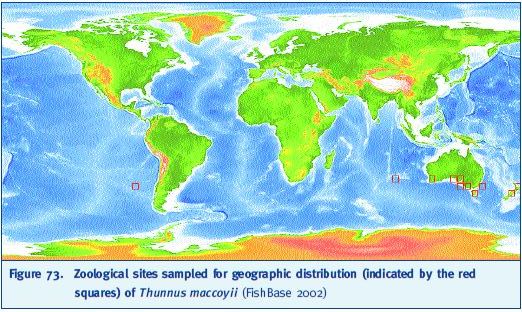5 TUNAS
Introduction and species identification
Tunas belong to Actinopterygii (ray-finned fishes), order Perciformes, family Scombridae which contains about 32 species and subspecies.
Two species of special commercial interest to fisheries and capture-based aquaculture are considered in this report: the northern bluefin tuna Thunnus thynnus [two subspecies were recognized by Gibbs and Collette (1967): Thunnus thynnus thynnus (Linnaeus, 1758) in the North Atlantic and Thunnus thynnus orientalis (Temminck and Schlegel, 1844) in the North Pacific] and the southern bluefin tuna Thunnus maccoyii. The Integrated Taxonomic Information System (www.itis.usda.gov) states that Thunnus orientalis was “formerly included in Thunnus thynnus (Linnaeus, 1758) as a subspecies”. However, Collette et al. (2001) support treating this Pacific taxon as a full species (Thunnus orientalis), quite separate from the Atlantic taxon (Thunnus thynnus). Our report follows the old approach.
The Atlantic subspecies of the northern bluefin tuna (Thunnus thynnus thynnus) is found from Labrador and Newfoundland south into the Gulf of Mexico and the Caribbean Sea and is also known off Venezuela and Brazil in the Western Atlantic; in the Eastern Atlantic it occurs from the Lofoten Islands off Norway south to the Canary Islands and the Mediterranean Sea. There is also a population off South Africa. The Pacific subspecies (T. thynnus orientalis) is known from the Gulf of Alaska to southern California and Baja California in the Eastern Pacific; in the Western Pacific it occurs from Sakhalin Island in the southern Sea of Okhotsk south to the northern Philippines.
Northern bluefin tuna are highly migratory, according to Annex I of the 1982 Convention on the Law of the Sea (www.oceanlaw.net/texts/losc.htm; FAO 1994). A pelagic species, it can be found seasonally coming close to the shore and can tolerate a wide range of temperatures. The fish shoal by size, sometimes together with albacore, yellowfin, bigeye, skipjack, etc. The northern bluefin tuna is one of the most important species in Japanese fisheries; its meat is utilized fresh for “sashimi” and, due to massive overfishing, it has become increasingly rare (Muus and Nielsen 1999).
During the spawning season, adult southern bluefin tuna (Thunnus maccoyii) migrate to tropical seas, off the west coast of Australia, up to 10°S. It is considered a highly migratory species (FAO 1994). Within 100 years its population will be below 500 mature individuals if the current exploitation continues (Matsuda et al. 1998). This species is highly prized in Japan for the “sashimi” market and specialized fisheries for sashimi-quality fish have been recently developed in New Zealand. Overfishing is severe for T. maccoyii and it was suggested the species should be declared an endangered species under the Endangered Species Act (1992) and listed in Appendix II of the Convention on International Trade in Endangered Species of Wild Fauna and Flora (CITES).
Tables 42-43 summarize the characteristics of the northern and southern bluefin tunas, while Figures 70-73 illustrate their appearance and geographical location.
Thunnus thynnus (Linnaeus, 1758)

Figure 70. Northern bluefin tuna (Thunnus thynnus) (FAO)
Table 42. Characteristics of the northern bluefin tuna (Thunnus thynnus) (FishBase 2002, modified)
Common name Northern bluefin tuna.
Size and age Maximum size of 458 cm TL (male/unsexed) and maximum weight 684 kg. Life span approximately 15 years.
Environment Brackish and marine species.
Climate and latitude Resilience Subtropical climate (70°N-40°S).
Resilience Minimum population doubling time of 4.5-14 years, with low resilience (Collette 1999).
Distribution The Atlantic subspecies is found from Labrador and Newfoundland south into the Gulf of Mexico and the Caribbean Sea to Venezuela and Brazil in the Western Atlantic; in the Eastern Atlantic from the Lofoten Islands off Norway south to the Canary Islands and the Mediterranean Sea. There is also a population off South Africa. The Pacific subspecies from the Gulf of Alaska to southern California and Baja California in the Eastern Pacific; in the Western Pacific from Sakhalin Island in the southern Sea of Okhotsk south to the northern Philippines.
Biology and ecology This pelagic species can be found seasonally coming close to shore, and can tolerate a wide range of temperatures; it feeds on small schooling fishes (anchovies, sauries, hakes), squids and red crabs.
Importance This is one of the most important species in Japanese aquaculture and fisheries; its meat is utilized fresh for sashimi and also canned (Frimodt 1995); it has become rare because of massive overfishing (Muus and Nielsen 1999).

Figure 71. Zoological sites sampled for geographic distribution (indicated by the red squares) of Thunnus thynnus (FishBase 2002)
Thunnus maccoyii (Castelnau, 1872)
Figure 72. Southern bluefin tuna (Thunnus maccoyii) (FAO)
Table 43. Characteristics of the southern bluefin tuna (Thunnus maccoyii) (FishBase 2002, modified)
Common name Southern bluefin tuna.
Size and age Male specimens reach 245 cm FL and a maximum weight of 260 kg; maximum life span 20 years.
Environment Pelagic, marine species.
Climate and latitude Subtropical climate (5-20°C) between 10°S and 60°S.
Resilience Doubling time of 4.5-14 years and low resilience (Collette and Nauen 1983).
Distribution It can be found in the Southern Hemisphere in temperate and cold seas, mainly between 30° and 50°S, to nearly 60°S. At spawning season, adults migrate to tropical seas off the west coast of Australia, up to 10°S.
Biology and ecology By maturity, most Southern bluefin tuna lead an oceanic, pelagic existence (Kailola et al. 1993). Spawning fish and larvae are encountered in waters with surface temperatures between 20- 30°C. T. maccoyii is an opportunistic feeder, preying on a wide variety of fishes, crustaceans, cephalopods, Sarpa salpa, and other marine animals.
Importance This species is very prized in Japan for the sashimi market and in New Zealand specialized fisheries for sashimi-quality has been developed. T. maccoyii is threatened by overfishing, was called to be declared an endangered species under the Endangered Species Act (1992) and listed on Appendix II of the Convention on International Trade in Endangered Species of Wild Fauna and Flora (CITES).

Figure 73. Zoological sites sampled for geographic distribution (indicated by the red squares) of Thunnus maccoyii (FishBase 2002)